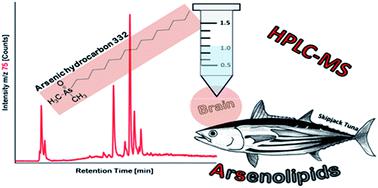当前位置:
X-MOL 学术
›
J. Anal. At. Spectrom.
›
论文详情
Our official English website, www.x-mol.net, welcomes your
feedback! (Note: you will need to create a separate account there.)
Lipid-soluble arsenic species identified in the brain of the marine fish skipjack tuna (Katsuwonus pelamis) using a sequential extraction and HPLC/mass spectrometry
Journal of Analytical Atomic Spectrometry ( IF 3.1 ) Pub Date : 2019-10-29 , DOI: 10.1039/c9ja00249a Michael Stiboller 1, 2, 3, 4, 5 , Fabiana P. Freitas 6, 7, 8, 9 , Kevin A. Francesconi 1, 2, 3, 4, 5 , Tanja Schwerdtle 10, 11, 12, 13 , António J. A. Nogueira 6, 7, 8, 9 , Georg Raber 1, 2, 3, 4, 5
Journal of Analytical Atomic Spectrometry ( IF 3.1 ) Pub Date : 2019-10-29 , DOI: 10.1039/c9ja00249a Michael Stiboller 1, 2, 3, 4, 5 , Fabiana P. Freitas 6, 7, 8, 9 , Kevin A. Francesconi 1, 2, 3, 4, 5 , Tanja Schwerdtle 10, 11, 12, 13 , António J. A. Nogueira 6, 7, 8, 9 , Georg Raber 1, 2, 3, 4, 5
Affiliation

|
Lipid-soluble arsenicals, so called arsenolipids, occur in appreciable quantities in various marine organisms including fish. In this study, arsenolipids as well water-soluble arsenic species were investigated in brain (9.1–17.4 mg As per kg; dry mass) and muscle (4.0–5.8 mg As per kg; dry mass) tissues in five specimens of the marine fish skipjack tuna (Katsuwonus pelamis). For this purpose, we developed a sequential extraction method whereby the freeze-dried tissue was first treated with pyridine (organic extract) followed by aqueous ammonium bicarbonate (water extract) to extract arsenolipids and water-soluble species, respectively. When the method was applied to the tuna tissues, the arsenic distribution for brain was 55% (organic extract), 30% (water extract) and 15% (pellet), whereas for muscle tissue the corresponding values were 20%, 55%, and 25%. Arsenic species in water and organic extracts of muscle and brain tissues were investigated by HPLC/mass spectrometry. For both tissues, the water extracts contained arsenobetaine as the major arsenic species together with small amounts of dimethylarsinate and trimethylarsine oxide; trace amounts of dimethylarsinoyl propionic acid were found only in brain tissues. Arsenic-containing hydrocarbons (AsHCs), were the major arsenolipids in both tuna brain and muscle. The arsenolipid content in brain ranged from 3.8–5.9 mg As per kg, whereas it was substantially lower in muscle (0.3–0.8 mg As per kg) reflecting arsenolipids' potential to cross the blood brain barrier and accumulate in the fish brain.
中文翻译:

使用顺序萃取和HPLC /质谱法在海鱼skip鱼(Katsuwonus pelamis)的大脑中鉴定出脂溶性砷物质
脂溶性砷,所谓的砷脂,在包括鱼类在内的各种海洋生物中大量存在。在这项研究中,在五个鱼类样本的大脑(每千克干重9.1–17.4 mg;干重)和肌肉(每千克干重4.0–5.8 mg)的组织中研究了砷脂以及水溶性砷物质鱼(Katsuwonus pelamis)。为此,我们开发了一种顺序提取方法,首先将冷冻干燥的组织先用吡啶(有机提取物)处理,然后再用碳酸氢铵水溶液(水提取物)处理,分别提取砷脂和水溶性物质。当该方法应用于金枪鱼组织时,脑中的砷分布为55%(有机提取物),30%(水提取物)和15%(丸子),而肌肉组织的相应值分别为20%,55%,和25%。通过HPLC /质谱法研究了水以及肌肉和脑组织的有机提取物中的砷种类。对于这两个组织,水提取物中都含有作为主要砷种类的砷甜菜碱,以及少量的二甲基砷酸和三甲基氧化砷。仅在脑组织中发现了痕量的二甲基ar基丙酸。含砷的碳氢化合物(AsHCs)是金枪鱼大脑和肌肉中的主要砷脂。大脑中的砷脂含量范围为每公斤3.8-5.9 mg,而肌肉中的砷含量低得多(每公斤0.3-0.8 mg),这反映了砷脂穿过血脑屏障并在鱼脑中蓄积的潜力。
更新日期:2019-10-29
中文翻译:

使用顺序萃取和HPLC /质谱法在海鱼skip鱼(Katsuwonus pelamis)的大脑中鉴定出脂溶性砷物质
脂溶性砷,所谓的砷脂,在包括鱼类在内的各种海洋生物中大量存在。在这项研究中,在五个鱼类样本的大脑(每千克干重9.1–17.4 mg;干重)和肌肉(每千克干重4.0–5.8 mg)的组织中研究了砷脂以及水溶性砷物质鱼(Katsuwonus pelamis)。为此,我们开发了一种顺序提取方法,首先将冷冻干燥的组织先用吡啶(有机提取物)处理,然后再用碳酸氢铵水溶液(水提取物)处理,分别提取砷脂和水溶性物质。当该方法应用于金枪鱼组织时,脑中的砷分布为55%(有机提取物),30%(水提取物)和15%(丸子),而肌肉组织的相应值分别为20%,55%,和25%。通过HPLC /质谱法研究了水以及肌肉和脑组织的有机提取物中的砷种类。对于这两个组织,水提取物中都含有作为主要砷种类的砷甜菜碱,以及少量的二甲基砷酸和三甲基氧化砷。仅在脑组织中发现了痕量的二甲基ar基丙酸。含砷的碳氢化合物(AsHCs)是金枪鱼大脑和肌肉中的主要砷脂。大脑中的砷脂含量范围为每公斤3.8-5.9 mg,而肌肉中的砷含量低得多(每公斤0.3-0.8 mg),这反映了砷脂穿过血脑屏障并在鱼脑中蓄积的潜力。











































 京公网安备 11010802027423号
京公网安备 11010802027423号